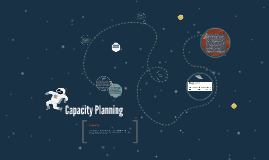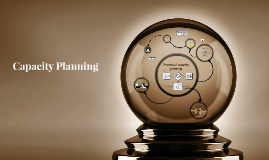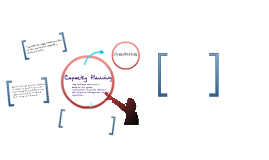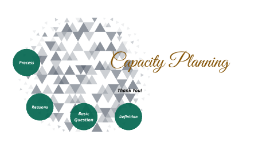capacity planning
Transcript: CAPACITY PLANNING Capacity Planning WHAT IS CAPACITY PLANNING Capacity is defined as the ability to achieve, store or produce. For an organization, capacity would be the ability of a given system to produce output within the specific time period. In operations, management capacity is referred as an amount of the input resources available to produce relative output over period of time. Goal of Capacity Planning The ultimate goal of capacity planning is to meet the current and future level of the requirement at a minimal wastage. The three types of capacity planning based on goal are lead capacity planning, lag strategy planning and match strategy planning. Factors Affecting Capacity Planning * production facility (layout, design, and location) *product line or matrix *production technology *human capital (job design, compensation) *operational structure (scheduling, quality assurance) *external structure ( policy, safety regulations) Strategic Capacity Planning STRATEGIC CAPACITY PLANNING A technique used to identify and measure overall capacity of production is referred to as strategic capacity planning. Strategic capacity planning is utilized for capital intensive resource like plant, machinery, labor, etc. Capacity planning based on the timeline is classified into three main categories long range, medium range and short range. Capacity Planning Classification Capacity Planning Classification Long range capacity of an organization is dependent on various other capacities like design capacity, production capacity, sustainable capacity and effective capacity. Design capacity is the maximum output possible as indicated by equipment manufacturer under ideal working condition Long Term Capacity Long Term Capacity The strategic capacity planning undertaken by organization for 2 to 3 years of a time frame is referred to as medium term capacity planning. Medium Term Capacity Medium Term Capacity The strategic planning undertaken by organization for a daily weekly or quarterly time frame is referred to as short term capacity planning. Short Term Capacity Short Term Capacity Three Basic Strategies Three Basic Strategies Capacity is expanded in anticipation of demand growth. This aggressive strategy is used to lure customers from competitors who are capacity constrained or to gain a foothold in a rapidly expanding market. It also allows companies to respond to unexpected surges in demand and to provide superior levels of service during peak demand periods. Capacity lead strategy Capacity lead strategy Capacity is expanded to coincide with average expected demand. This is a moderate strategy in which managers are certain they will be able to sell at least some portion of expanded output, and endure some periods of unmet demand. Approximately half of the time capacity leads demand, and half of the time capacity lags demand. Average capacity strategy Average capacity strategy Capacity is increased after an increase in demand has been documented. This conservative strategy produces a higher return on investment but may lose customers in the process. It is used in industries with standard products and cost-based or weak competition. The strategy assumes that lost customers will return from competitors after capacity has expanded. Capacity lag strategy Capacity lag strategy As demand grows, a lead, lag, or average capacity strategy can be applied. As demand grows, a lead, lag, or average capacity strategy can be applied. Click to edit text Capacity Expansion Strategies Consider higher education's strategy in preparing for a tripling of the state's college-bound population in the next decade. An established university, guaranteed applicants even lean years, may follow a capacity lag strategy. A young university might lead capacity expansion in hopes of capturing students not admitted to the more established universities. A community college may choose the average capacity strategy to fulfill its mission of educating the state's youth but with little risk. How much to increase capacity depends on : Capacity can be increased incrementally or in large steps. (1) the volume and certainty of anticipated demand (2) strategic objectives in terms of growth (3) the costs of expansion and operation. Best Operating Level for a Hotel • Fixed costs can be spread over a larger number of units, • Production or operating costs do not increase linearly with output levels, • Quantity discounts are available for material purchases, and • Operating efficiency increases as workers gain experience. Capacity Planning Decision Capacity Planning Decision Three Steps of Capacity Planning Three Steps of Capacity Planning Determine Service Level Requirements Analyze Current Capacity Planning for future What are the models and techniques that are useful for capacity planning? Models and Techniques Used for Capacity Planning

















